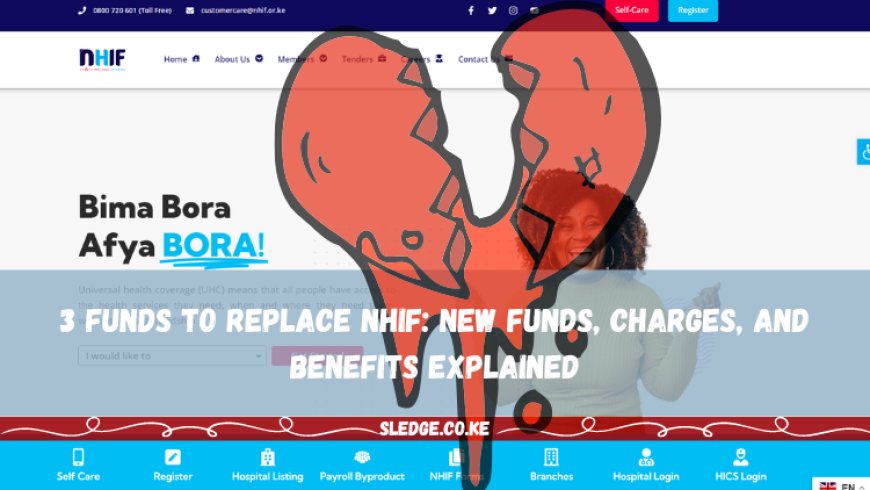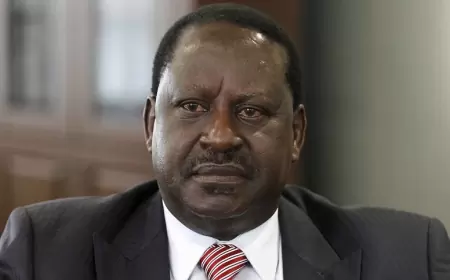3 Funds To Replace NHIF: Type Of Funds, Charges, and Benefits Explained
Learn about the groundbreaking changes in Kenya's healthcare landscape as President Ruto's administration introduces new funds to replace NHIF. Explore the impact on accessibility, quality, and affordability of medical care.

In a significant move to transform Kenya's healthcare landscape, President William Ruto's Cabinet has approved Bills that pave the way for repealing the National Health Insurance Fund (NHIF). This strategic shift aims to advance the cause of Universal Health Coverage (UHC) and ensure that every Kenyan can access quality medical care without financial strain. The proposed changes introduce a trio of funds that promise to revolutionize the healthcare sector: the Primary Health Care Fund, the Social Insurance Fund, and the Emergency, Chronic, and Critical Illness Fund. Let's delve into the details of this groundbreaking transformation and explore how it will impact citizens' lives.
Key Takeaways
- President William Ruto's Cabinet has approved Bills to replace the NHIF with three new funds for Universal Health Coverage (UHC).
- The three funds include the Primary Health Care Fund, Social Insurance Fund, and Emergency, Chronic, and Critical Illness Fund.
- The Social Insurance Fund will operate on a shared responsibility model, with individual and government contributions.
- The Emergency, Chronic, and Critical Illness Fund will provide comprehensive coverage for chronic conditions, funded entirely by the state.
- Private insurance is expected to become more affordable as the burden of chronic illnesses shifts to the government-funded fund.
- The new funds aim to achieve UHC by providing comprehensive healthcare coverage for all Kenyans.
- The collaboration between public and private healthcare provisions exemplifies the government's commitment to citizens' health and well-being.
A Glimpse of the New System
President Ruto's vision of achieving Universal Health Coverage has materialized through the formulation of three vital funds: the Primary Health Care Fund, the Social Insurance Fund, and the Emergency, Chronic, and Critical Illness Fund. This tripartite structure aims to tackle health challenges at various levels, catering to preventive, promotive, and curative healthcare needs. By replacing the current NHIF model with this multi-faceted approach, the government seeks to enhance healthcare accessibility, quality, and affordability for all Kenyans.
Understanding the Funds
Primary Health Care Fund
This fund is the bedrock of the new healthcare system, designed to provide financial support to counties to improve district hospitals and dispensaries. Kenyans can access medical services at government hospitals without financial barriers, ensuring that the most vulnerable citizens can receive care without worrying about costs.
Social Insurance Fund
The new Social Insurance Fund operates on a shared responsibility model, where the individual and the government contribute towards healthcare coverage. While the exact contributions are yet to be finalized, Kenyans are expected to continue to pay a reasonable monthly premium, similar to the current NHIF structure. This fund will act as a social safety net, assuring citizens of healthcare protection up to a specific limit.
Emergency, Chronic, and Critical Illness Fund
Chronic illnesses like cancer, high blood pressure, and diabetes pose significant healthcare challenges. The government will establish a fund dedicated to these critical conditions to address this. Unlike private insurance, often excluding chronic illnesses, this fund will provide comprehensive coverage funded entirely by the state. This approach aims to reduce the financial burden on individuals and families facing these medical challenges.
Benefits Beyond the Surface
Jubilee Insurance Group Chief Executive Officer (CEO) Julius Kipngetich highlights a noteworthy outcome of this transformative shift – the reduction in private health insurance costs. With establishing the Emergency, Chronic, and Critical Illness Fund, private insurance can focus on supplementary coverage rather than bearing the heavy burden of chronic illnesses. As a result, premiums for private insurance are expected to decrease, making quality healthcare more affordable for those seeking additional coverage beyond the government-funded funds.
Striding Towards Universal Health Coverage
If these Bills receive parliamentary approval, Kenya will take a significant leap towards achieving Universal Health Coverage. Under this comprehensive model, every Kenyan will possess a government card entailing coverage from the three newly established funds. This approach harmoniously integrates private insurance with government provisions, amplifying healthcare access and quality. This collaborative effort between the public and private sectors aligns with international practices, ensuring that healthcare companies and government systems work hand in hand to secure the health and well-being of citizens.
READ ALSO: D-Pay Payslip Download: Register, Login, and Benefits Explained
Conclusion
President Ruto's administration's bold move to replace the NHIF with the Primary Health Care Fund, Social Insurance Fund, and Emergency, Chronic, and Critical Illness Fund marks a transformative moment in Kenya's healthcare sector. The structured approach of these funds promises to tackle healthcare challenges from all angles, ensuring that Kenyans have access to quality medical care without financial barriers. By striking a harmonious balance between public and private healthcare provisions, this reform exemplifies the government's commitment to the health and well-being of its citizens.
FAQs
What motivated the government to replace the NHIF with new funds?
The government's motivation behind this move is to enhance healthcare accessibility, quality, and affordability for all Kenyans. The new funds aim to provide comprehensive coverage for preventive, promotive, and curative healthcare needs, addressing various challenges citizens face.
How will the Social Insurance Fund work?
The Social Insurance Fund will operate on a shared responsibility model, with individual and government contributions. While exact contribution amounts are yet to be finalized, the fund aims to provide healthcare protection up to a specific limit, ensuring citizens can access medical services without worrying about costs.
What impact will the Emergency, Chronic, and Critical Illness Fund have?
The Emergency, Chronic, and Critical Illness Fund will provide comprehensive coverage for chronic illnesses like cancer, high blood pressure, and diabetes. By fully funding this fund, the government aims to alleviate the financial burden on individuals facing these medical challenges and make quality healthcare more accessible.
How will the new funds work together to achieve Universal Health Coverage?
The new funds will work together to ensure a comprehensive healthcare system covers every Kenyan. By integrating government-funded provisions with private insurance coverage, the system aims to provide a holistic and inclusive approach to healthcare, benefiting citizens across the board.
What role will private insurance play in this new healthcare system?
Private insurance will complement the government-funded funds by offering supplementary coverage beyond the services provided by the new funds. With the burden of chronic illnesses taken care of by the government, private insurance can focus on additional services, leading to lower premiums and increased affordability.
How will this healthcare reform impact Kenya's economy?
This healthcare reform is expected to impact Kenya's economy positively. By ensuring that citizens have access to quality healthcare, the overall health and productivity of the population are likely to improve. Additionally, the collaboration between public and private sectors can contribute to the growth of the healthcare industry and the economy.
Disclaimer
The information provided in this article is based on current proposals and government initiatives. Changes and updates may occur as the legislative process progresses. Readers are advised to stay informed through official government sources and reputable news outlets for the latest information on healthcare reforms in Kenya.












































































